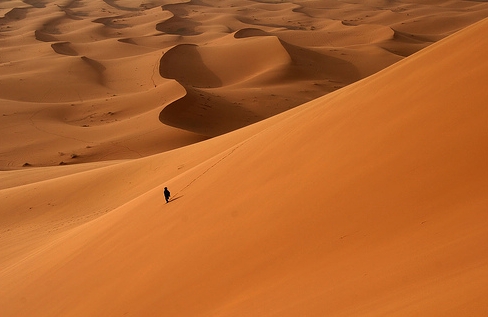Reading
Sahara Desert

Read the passage and do the task that follows
The Sahara Desert is located in the northern portion of Africa and covers over 9,000,000 sq km or roughly 10% of the continent. It is bounded in the east by the Red Sea and it stretches west to the Atlantic Ocean. To the north, the Sahara Desert's northern boundary is the Mediterranean Sea, while in the south it ends at the Sahel, an area where the desert landscape transforms into a semi-arid tropical savanna. Since the Sahara Desert makes up nearly 10% of the African continent, the Sahara is often cited as the world's largest desert. This is not entirely true, however, as it is only the world's largest hot desert.
Most of the water found in the Sahara today is in the form of seasonal or intermittent streams. The only permanent river in the desert is the Nile River that flows from Central Africa to the Mediterranean Sea. Other water in the Sahara is found in underground aquifers and in areas where this water reaches the surface, there are oases and sometimes small towns or settlements like the Bahariya Oasis in Egypt and Ghardaïa in Algeria.
In addition to being extremely dry, the Sahara is also one of the hottest regions in the world. The average annual temperature for the desert is 30°C but during the hottest months temperatures can exceed 50°C, with the highest temperature ever recorded at 58°C in Aziziyah, Libya.
Due to the high temperatures and arid conditions of the Sahara Desert, the plant life in the Sahara Desert is sparse and includes only around 500 species. These consist mainly of drought and heat resistant varieties and those adapted to salty conditions where there is sufficient moisture. The harsh conditions found in the Sahara Desert have also played a role in the presence of animal life in the Sahara Desert. In the central and driest part of the desert there are around 70 different animal species, 20 of which are large mammals like the spotted hyena. Other mammals include the gerbil, sand fox and Cape hare. Reptiles like the sand viper and the monitor lizard are present in the Sahara as well.
It is believed that people have inhabited the Sahara Desert since 6000 BCE and earlier. Since then, Egyptians, Phoenicians, Greeks and Europeans have been among the peoples in the area. Today the Sahara's population is around 4 million with the majority of the people living in Algeria, Egypt, Libya, Mauritania and Western Sahara. Most of the people living in the Sahara today do not live in cities; instead they are nomads who move from region to region throughout the desert. Because of this, there are many different nationalities and languages in the region but Arabic is most widely spoken. For those who do live in cities or villages on fertile oases, crops and the mining of minerals like iron ore (in Algeria and Mauritania) and copper (in Mauritania) are important industries that have allowed population centers to grow.
Nguồn: Internet
 Lớn hơn
Lớn hơn Nhỏ hơn
Nhỏ hơn








0 comments:
Post a Comment